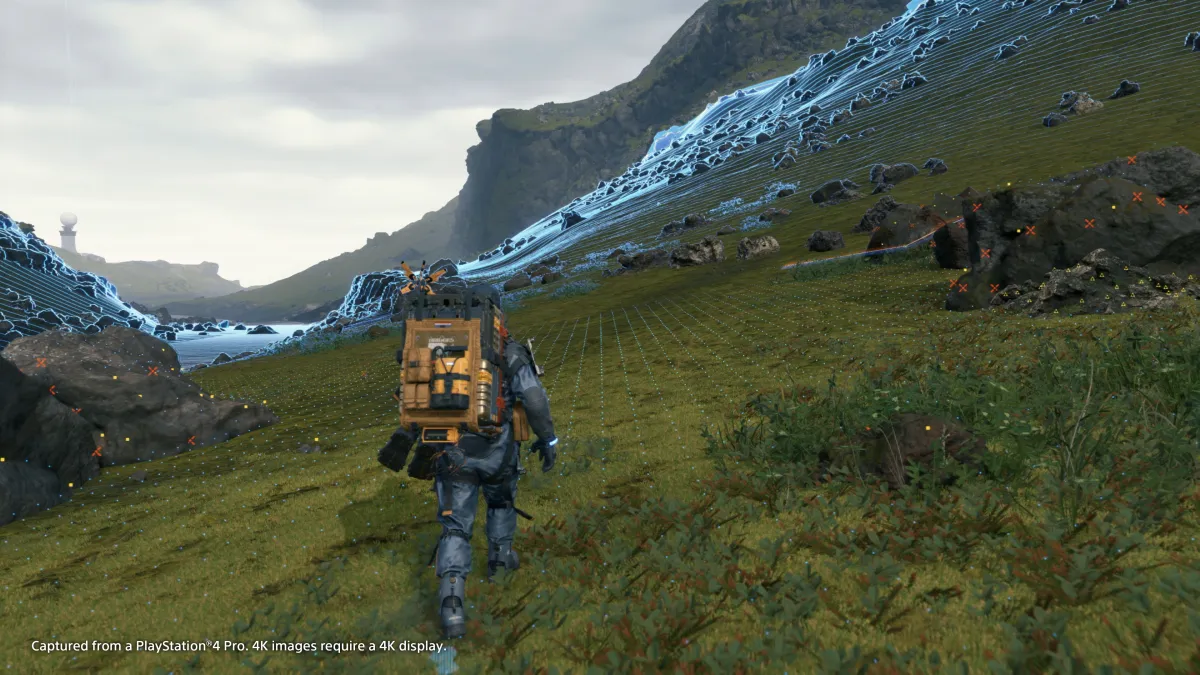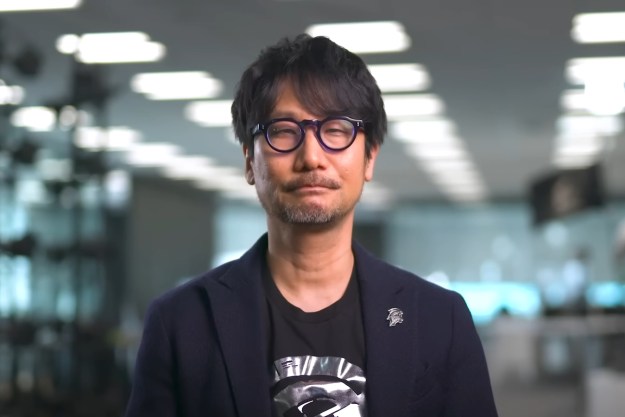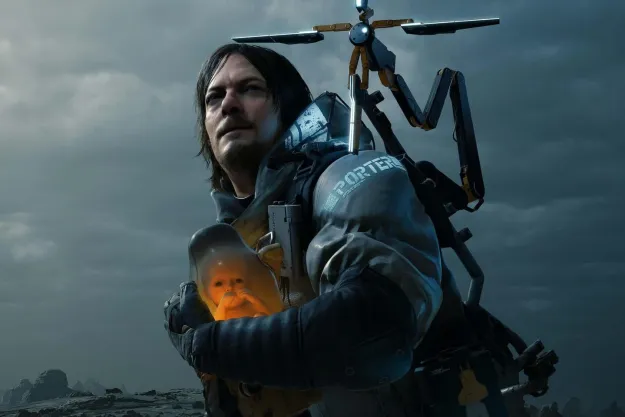
- Rich world-building
- Excellent narrative aided by top-notch performances
- Tense and clever stealth sections
- Thoughtful social features
- Core gameplay is slow and repetitive
- Open world feels empty
No matter where you fall on the political spectrum, the consensus seems to be that America is divided. Countless artists have spent the past 3 years trying to tackle that issue, searching for some morsel of wisdom that might help repair a fractured nation. Surprisingly, the most timely, resonant piece of art on the subject may not come from a book or a movie, but from a video game.
Death Stranding is the latest game from Hideo Kojima, the visionary behind the Metal Gear Solid franchise. It’s also his first project following a high-profile split with Konami, which allowed him to set up his own independent studio, Kojima Productions. With that newfound freedom, Kojima has created a bold, ambitious project that seeks to join the dialogue about America’s current anxieties.
The irony is that in trying to create a piece about bridging national division, Kojima may have created his most divisive game yet. Death Stranding is an absolute marvel on a narrative and technical front, but struggles to balance meaningful design choices with ones that are actually engaging to play in a long-form open world game.
Rich story and world building
Within the first 2 hours, Death Stranding throws a lot of setup at you. The game is set in a post-apocalyptic America, where some sort of mysterious event has plunged the country into darkness and destroyed several channels of communications between cities. You play as Sam Bridges, a porter who delivers packages from location to location– an extremely valuable profession in America’s current state.
Sam is approached by a government group led by the hilariously named Die-Hardman, who sends him on a mission to “Make America whole again” (Kojima isn’t one for subtlety) by traveling across the entire country, linking cities to a chiral network in an attempt to literally reconnect the country.
I’m not going to get into story spoilers because I’d need the entire review to even scratch the surface. Death Stranding’s story is incredibly dense, packed to the brim with characters, cutscenes, and written lore. Narrative has always been Kojima’s strong suit, and he really gets to flex his muscles here, creating an enthralling science-fiction setting that’s so rich with detail. Think of it as “Isaac Asimov does Infinite Jest” but with Kojima’s signature blend of horror, humor, and pulp.

The story is especially effective thanks to the game’s top-notch voice cast, which includes established film actors like Norman Reedus and Léa Seydoux as well as cameos from Conan O’Brien and Geoff Keighley. Acting in games has improved drastically over the years as new technology has allowed for more expressive animations that bring voices to life, and Death Stranding pushes the medium to its farthest reaches. The fact that Mads Mikkelsen delivers one of the best performances of his career here really speaks to how gigantic a step forward this is for the games as a narrative medium.
On a technical level, Death Stranding is an incredible achievement that not only raises the bar for this generation, but already sets it extremely high for next year’s new consoles. Combine that with the game’s nuanced, timely narrative and you have the perfect send-off for the 2010’s, thoughtfully recapping a decade of political turmoil.
Trudging mechanics
The gameplay, on the other hand, is a different story. The bulk of the game revolves around delivering packages from waypoint to waypoint. Sounds simple, right? Well, not quite. The gameplay tips section of your pause menu is longer than your average novellas, sporting a seemingly endless list of mechanics.
Despite the smart design ideas, it’s hard to describe the gameplay as enjoyable.
Here are the basics. You start every mission by loading up Sam with cargo and tools to help traverse the world. Rather than having bottomless pockets, Sam physically has to carry everything. The more weight you put on Sam, the harder it is to walk. Most of your time is spent managing your stamina and balance, using the left and right triggers to keep Sam from tipping over or getting knocked down by strong winds or currents. As far as walking mechanics go, everything here is well considered, turning simple traversal into an active experience that requires you to pay attention to every step you take.

Despite the smart design ideas, it’s hard to describe the gameplay as enjoyable. Much of the game is spent walking back and forth between the same destinations, over and over and over again. Along the way, you’ll experience a gigantic, America-spanning open world, which is as gorgeous to look at as it is boring to move across. Imagine Metal Gear Solid V’s empty world, but with steeper hills.
As you progress, you’ll unlock more and more tools to help alleviate the slow pace, like vehicles and ziplines, but many of those end up getting negated as the terrain becomes rougher. There were several instances when I’d craft a truck, only to abandon it moments later when I’d find myself stuck between rocks Austin Powers-style.
The game’s a little more successful when it comes to combat and stealth, but there are still asterisks on both. During your travels, you’ll be hunted by scavengers who are out to steal your cargo. At first, you’ll only have your fists to help you, leading to hours of sluggish fist fights. Fights fortunately get more engaging once you unlock non-lethal weapons that use your health as ammo, leading to situations where you have to weigh the benefits of fight or flight, but it takes a long time to get to that point.
It should come as no surprise that the stealth portions contain some of Kojima’s best ideas.
It should come as no surprise that the stealth portions contain some of Kojima’s best ideas. At various points, you’ll come across patches of land inhabited by BTs, spectral entities that can only be revealed by the baby strapped to your chest (like I said, it would take too long to explain all of this here).
In these areas, you’ll need to pay attention to a host of clever visual tells that help you avoid BTs. These moments are incredibly tense, forcing you to tread carefully to keep your cargo in tact. But these encounters can get repetitive after a while, often forcing you to abandon your most efficient tools and slowing down an already slow pace.
It can all get very tedious, but that’s kind of the point. Kojima isn’t necessarily interested in entertaining you, even admitting that the game doesn’t get “fun” until about halfway through. Instead, you’re supposed to feel how difficult Sam’s job is. There’s a reason that porters are so respected in this world; it’s a dangerous slog that no one wants to do. In that sense, these are smart choices that are loyal to the game world. But the ideas feel too high-concept for their own good at times, often making them feel like busy work you have to do to unlock cutscenes.
Social gaming
While Death Stranding sounds like a standard adventure game on paper, it does contain some really outstanding new ideas. Kojima has often referred to the game as the first in a new genre of “social strand” games, and it’s immediately clear that he’s sincere about it. The game is filled with a host of social components that make this strictly single-player experience feel like an MMO.
The heart of the social implementation comes in the form of shared structure building. That is, if you build a bridge over a big river in your game, it’ll appear in someone else’s too. Not only that, but you can also collect materials and use them to upgrade other player’s structures, making them more effective for everyone who comes across them.

Here’s a particularly stunning example. I was in the middle of a mission, traveling across a gigantic stretch of empty land. A while later, I had to turn around and head back to point A again. But something had changed. Now, there was a gigantic highway stretching all the way back to where I needed to go.
As I soon discovered, other players had spent the day contributing materials to several “auto pavers” which in turn rebuilt a highway over difficult terrain. I was almost moved to tears. A bunch of players who didn’t know one another had unknowingly worked together to make the game world a better place for me and each other.
There’s even more to it than that. You can set up postboxes and leave equipment and packages for other players to deliver. You can request items and have other players deliver them to you. You can even award players’ structures ‘likes’ that will help them rank up their skills, which is a refreshingly non-cynical commentary on social media’s ability to connect us (and an unsurprising one considering how much Kojima seems to love Twitter nowadays).
The game is filled with a host of social components that make this strictly single-player experience feel like an MMO.
All of these ideas are both functional and engaging, a balance that the core gameplay often fails to strike. The game is about coming together to repair a broken world, and that’s literally what you have to do to make the game better. Despite being set in a post-apocalyptic world, this concept makes the game feel utopian. You aren’t winning at the expense of 99 other players; you’re becoming part of a whole.
That idea of togetherness is going to be a lot easier to achieve in the game than it will be in real life. Comb through social media and you’ll already find plenty of heated arguments about the game’s balance of gameplay and narrative. But “coming together” isn’t always about reaching a consensus; it’s about contributing to the cultural dialogue rather than trying to control it.
Microtransactions
Miraculously, there are no microtransactions to speak of in Death Stranding. No cosmetic updates, no content locked behind a paywall. What you pay for is what you get, and it’s a lot.
Our Take
Death Stranding is The Tree of Life of videogames. Some people will hail it as a technical and narrative masterpiece that pushes the medium forward. Others will simply be bored to tears by the slow, repetitive gameplay. Both takes are valid. Death Stranding is a bold project that’s sure to be as divisive as the political anxiety it’s commenting on. It won’t change the minds of Kojima detractors who think he should just make movies, but the game’s thoughtful social components showcase why he still plays such a vital role in the games industry.
Is there a better alternative?
While there isn’t a game that’s quite like this, Horizon Zero Dawn has a lot of the same narrative and technical strengths, but with a more consistently engaging gameplay.
Want more options? Check out our favorite games for the PlayStation 4.
How long will it last?
If you’re just following the main path and avoiding the endless list of side quests, you can complete this in about 30 hours. But every extra package you decide to deliver can add significant time to your play count, which can make it much longer for committed players.
Should you buy it?
Yes. Death Stranding can be a slog at times, but its innovation and compelling story will see you through.
Editors' Recommendations
- Death Stranding 2: release date speculation, trailers, gameplay, and more
- Death Stranding 2 gets a title, release window, and a bonkers new trailer
- Everything we know about about Hideo Kojima’s OD: trailer, platforms, and more
- Macs are getting a ‘Game Mode’ feature and Death Stranding: Director’s Cut
- You can get Death Stranding for free right now on PC. Here’s how





